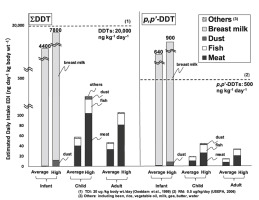当前位置:
X-MOL 学术
›
Chemosphere
›
论文详情
Our official English website, www.x-mol.net, welcomes your feedback! (Note: you will need to create a separate account there.)
Intake of DDT and its metabolites through food items among reproductive age women in Bangladesh
Chemosphere ( IF 8.8 ) Pub Date : 2017-09-13 , DOI: 10.1016/j.chemosphere.2017.09.041 Rehnuma Haque , Tsukasa Inaoka , Miho Fujimura , Akhtar Sk Ahmad , Daisuke Ueno
Chemosphere ( IF 8.8 ) Pub Date : 2017-09-13 , DOI: 10.1016/j.chemosphere.2017.09.041 Rehnuma Haque , Tsukasa Inaoka , Miho Fujimura , Akhtar Sk Ahmad , Daisuke Ueno

|
This study was conducted to make clear the major intake route of DDT in Bangladesh people to develop strategy and policy that could lead to a reduction in body burden especially in the reproductive age women. The concentrations of several POPs (DDT, PCBs, chlordanes, HCHs, HCB, and PeCB) were quantified in food items, human breast milk and house dust collected in Bangladesh in 2011–2012. Among the POPs analyzed in this study, DDT and its metabolites (ΣDDT) showed the highest concentration. The highest median ΣDDT concentration was found in meat (1.3–1100 ng g−1 wet weight) and house dust (30–1100 ng g−1 dry weight), and followed by human breast milk (20–55 ng g−1 wet weight). Estimated daily intake (EDI) was calculated using the DDT concentrations in food items. The highest intake of DDT was found in an infant and 99% of it was via breast milk feeding. DDT intake via consumption of beef accounted for 69% and 72% of that found in children and adults, respectively. The total EDI of DDT did not exceed the tolerable daily intake proposed by the WHO, but the EDI of p,p`-DDT exceeded the oral reference dose proposed by the US Environmental Protection Agency. Further research is required to clarify the reason for the high levels of DDT in beef, which seems to be the major intake route of DDT for women of reproductive age in Bangladesh.
中文翻译:

孟加拉国育龄妇女通过食物摄入滴滴涕及其代谢产物
进行这项研究的目的是弄清孟加拉国人民摄入滴滴涕的主要途径,以制定战略和政策,以减轻身体负担,特别是在育龄妇女中。在2011-2012年孟加拉国收集的食品,母乳和室内灰尘中,定量了几种POPs(滴滴涕,PCBs,氯丹,六氯环己烷,六氯苯和六氯苯)的浓度。在这项研究分析的持久性有机污染物中,滴滴涕及其代谢物(ΣDDT)的浓度最高。在肉类(1.3–1100 ng g -1湿重)和室内灰尘(30–1100 ng g -1干重)中发现了最高的ΣDDT中位数,其次是人母乳(20–55 ng g -1湿重)。使用食物中的DDT浓度计算估计的每日摄入量(EDI)。婴儿中DDT的摄入量最高,其中99%是通过母乳喂养的。通过食用牛肉摄入的滴滴涕分别占儿童和成人摄入量的69%和72%。DDT的EDI总量不超过WHO提出的每日容许摄入量,但是p, p`-DDT的EDI超过美国环境保护署建议的口服参考剂量。需要进一步的研究来阐明牛肉中DDT含量高的原因,这似乎是孟加拉国育龄妇女DDT的主要摄入途径。
更新日期:2017-09-14
中文翻译:

孟加拉国育龄妇女通过食物摄入滴滴涕及其代谢产物
进行这项研究的目的是弄清孟加拉国人民摄入滴滴涕的主要途径,以制定战略和政策,以减轻身体负担,特别是在育龄妇女中。在2011-2012年孟加拉国收集的食品,母乳和室内灰尘中,定量了几种POPs(滴滴涕,PCBs,氯丹,六氯环己烷,六氯苯和六氯苯)的浓度。在这项研究分析的持久性有机污染物中,滴滴涕及其代谢物(ΣDDT)的浓度最高。在肉类(1.3–1100 ng g -1湿重)和室内灰尘(30–1100 ng g -1干重)中发现了最高的ΣDDT中位数,其次是人母乳(20–55 ng g -1湿重)。使用食物中的DDT浓度计算估计的每日摄入量(EDI)。婴儿中DDT的摄入量最高,其中99%是通过母乳喂养的。通过食用牛肉摄入的滴滴涕分别占儿童和成人摄入量的69%和72%。DDT的EDI总量不超过WHO提出的每日容许摄入量,但是p, p`-DDT的EDI超过美国环境保护署建议的口服参考剂量。需要进一步的研究来阐明牛肉中DDT含量高的原因,这似乎是孟加拉国育龄妇女DDT的主要摄入途径。



























 京公网安备 11010802027423号
京公网安备 11010802027423号